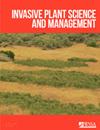三种外来入侵同系茶花(Dipsacus)物种的种群结构
IF 1.2
4区 生物学
Q3 PLANT SCIENCES
引用次数: 0
摘要
旧大陆 Dipsacus L.属的三个物种被认为是美洲的入侵物种,但它们在传播、繁殖和遗传多样性方面可能有所不同。入侵方式的不同可能表明每个物种需要不同的管理技术。我们对来自美国、阿根廷和欧亚大陆的 69 个种群中的 572 株植物进行了遗传分析,目的是分析这些物种入侵的分类、多样性、繁殖方式、种群结构和始祖效应,并寻找最近或正在进行的杂交的证据。我们发现 D. sativus 的多样性最低,可能比其他物种 D. fullonum 和 D. laciniatus 更依赖自花授粉。我们没有发现入侵物种内部杂交的证据,也不支持 D. sativus 作为 D. fullonum 的一个亚种。从美国到原产地的 D. fullonum 与匈牙利和西班牙的基因匹配最接近,而从阿根廷到原产地的 D. fullonum 与西班牙的基因匹配最接近。美国的 Dipsacus laciniatus 与俄罗斯的样本匹配度最高。有关这三种杂草 Dipsacus 的种群结构信息可以帮助我们了解它们的入侵过程,并为它们的管理和生物防治计划的制定提供启示。本文章由计算机程序翻译,如有差异,请以英文原文为准。
Population structure of three invasive congeneric teasel (Dipsacus) species
Three species of the Old World genus Dipsacus L. are considered invasive in the Americas, yet they may differ in how they spread, reproduce, and in genetic diversity. Differences in invasion method may suggest that different management techniques are needed for each species. We performed genetic analyses on 572 plants in 69 populations from the USA, Argentina, and Eurasia with the goals of analyzing taxonomy, diversity, mode of reproduction, population structure and founder effect of each of these species’ invasions, as well as looking for evidence of recent or ongoing hybridization. We found D. sativus to be lowest in diversity and possibly relying on self-pollination more than the other species, D. fullonum and D. laciniatus . We found no evidence of hybridization within the invasions and no support for D. sativus as a subspecies of D. fullonum . The closest genetic matches of D. fullonum from USA to the native range were with Hungary and Spain, while the closest match for D. fullonum between Argentina and the native range was with Spain. Dipsacus laciniatus from the USA most closely matched with samples from Russia. Population structure information regarding these three weedy Dipsacus species can help us understand their invasive processes as well as give insight into their management and the development of a biological control program.
求助全文
通过发布文献求助,成功后即可免费获取论文全文。
去求助
来源期刊

Invasive Plant Science and Management
PLANT SCIENCES-
CiteScore
2.20
自引率
9.10%
发文量
24
审稿时长
6-12 weeks
期刊介绍:
Invasive Plant Science and Management (IPSM) is an online peer-reviewed journal focusing on fundamental and applied research on invasive plant biology, ecology, management, and restoration of invaded non-crop areas, and on other aspects relevant to invasive species, including educational activities and policy issues. Topics include the biology and ecology of invasive plants in rangeland, prairie, pasture, wildland, forestry, riparian, wetland, aquatic, recreational, rights-of-ways, and other non-crop (parks, preserves, natural areas) settings; genetics of invasive plants; social, ecological, and economic impacts of invasive plants and their management; design, efficacy, and integration of control tools; land restoration and rehabilitation; effects of management on soil, air, water, and wildlife; education, extension, and outreach methods and resources; technology and product reports; mapping and remote sensing, inventory and monitoring; technology transfer tools; case study reports; and regulatory issues.
 求助内容:
求助内容: 应助结果提醒方式:
应助结果提醒方式:


